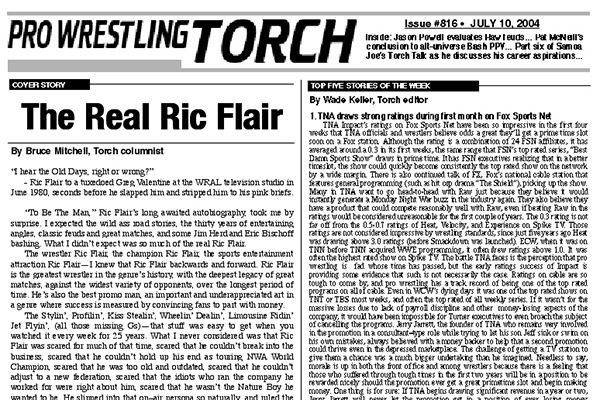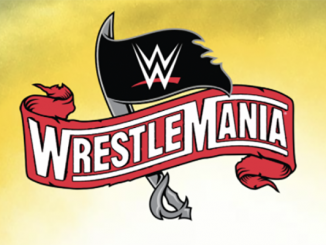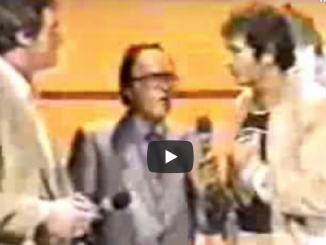
SPOTLIGHTED PODCAST ALERT (YOUR ARTICLE BEGINS A FEW INCHES DOWN)...
This month marks the 25th Anniversary of Bruce Mitchell becoming a Pro Wrestling Torch Newsletter columnist. No single person has influenced the editorial tone and direction of the Torch brand over the years than Bruce, who brought a hard-hitting, supremely well-informed, speak-truth-to-power approach to his writing. He went after sacred cows out of the gate, such as the beloved among “smart fans” (today’s “Internet fans” or “IWC,” I suppose) Eddie Gilbert and Jim Cornette. He also went hard after people in positions of authority and power who were abusing or misusing that power, or just not delivering a worthy product. He has also applauded and paid tribute to the greatest moments and movements in pro wrestling over the last 25 years, with a style of writing that has yet to be matched anywhere, I contend (despite Bill Simmons’s arrogant and uninformed contention last year that no one wrote at a high level about pro wrestling until his “Masked Man” columnist came along).
To celebrate and highlight Bruce’s stellar 25 years of influential and eloquent truth-telling about this fascinating industry, we’ll be featuring a single column from each of the last 25 years each of the first 25 days this month. His long-form columns were a pioneer approach to pro wrestling journalism, and the next 25 years you’ll experience a slice of what it is that has earned Bruce Mitchell widespread recognition within the industry over the years as being “Pro Wrestling’s Most Respected Columnist.” We began on Oct. 1st with his very first column, from Pro Wrestling Torch Newsletter #89 (cover dated Oct. 5, 1990).
Today we feature his column from the July 10, 2004 edition of the Pro Wrestling Torch Weekly Newsletter (#816) titled “The Real Ric Flair” that went in-depth on the just-released autobiography of the Nature Boy.
NOTE: VIP members can access hundreds of Mitchell columns instantly in the BRUCE MITCHELL LIBRARY here, part of the massive unmatched online archives of insider wrestling coverage from over the past 28 years.
===
HEADLINE: “The Real Ric Flair”
COVER STORY from JULY 10, 2004
PWTORCH NEWSLETTER #816
By Bruce Mitchell, Torch columnist
“I hear the Old Days, right or wrong?”
– Ric Flair to a tuxedoed Greg Valentine at the WRAL television studio in June 1980, seconds before he slapped him and stripped him to his pink briefs.
“To Be The Man,” Ric Flair’s long awaited autobiography, took me by surprise. I expected the wild ass road stories, the thirty years of entertaining angles, classic feuds and great matches, and some Jim Herd and Eric Bischoff bashing. What I didn’t expect was so much of the real Ric Flair.
The wrestler Ric Flair, the champion Ric Flair, the sports entertainment attraction Ric Flair – I knew that Ric Flair backwards and forward. Ric Flair is the greatest wrestler in the genre’s history, with the deepest legacy of great matches, against the widest variety of opponents, over the longest period of time. He’s also the best promo man, an important and underappreciated art in a genre where success is measured by convincing fans to part with money.
The Stylin’, Profilin’, Kiss Stealin’, Wheelin’ Dealin’, Limousine Ridin’ Jet Flyin’, (all those missing Gs) – that stuff was easy to get when you watched it every week for 25 years. What I never considered was that Ric Flair was scared for much of that time, scared that he couldn’t break into the business, scared that he couldn’t hold up his end as touring NWA World Champion, scared that he was too old and outdated, scared that he couldn’t adjust to a new federation, scared that the idiots who ran the company he worked for were right about him, scared that he wasn’t the Nature Boy he wanted to be. He slipped into that on-air persona so naturally, and ruled the bar after the show so easily, that insecurity sure wasn’t the first thing that came to mind watching this guy operate.
Ric Flair, of all people, didn’t know he was Ric Flair. The wrestler whose greatest gimmick was his complete sense of confidence, doesn’t have that confidence in his daily life. The irony is that that lack has driven him for 32 years and continues to drive him to this day.
Ric Flair was the last person I would have figured to have anxiety attacks so crippling that friends such as Kevin Sullivan and Arn Anderson had to check on him through the night, or to have been in therapy for over ten years, or to struggle (and take responsibility) every day for the price his family has paid emotionally for him to live his gimmick so thoroughly.
Even if he had his doubts and worries behind the facade, Flair wasn’t the type to show them before this book. There was always the next match, the next town, the next bar tab to pick up. One of his faults through his career has been his tendency to shmooze past everyone, avoiding problems by telling people what they wanted to hear. Konnan, in a long ago “Torch Talk,” once described Flair telling him how great he was, then tearing him down as soon as (he thought) he was out of earshot. Part of Flair’s desire to put over everyone in the ring from the lowliest jobber to the most selfish booker came not just from professionalism, but from a desire to have everyone like him, and in that way keep his place in the industry.
So I always figured a Ric Flair autobiography would have some cool pictures (this does), some stories about how mainstream stars like Michael Jordan and Charles Barkley were big fans (nothing), a bunch of Ricky Steamboat and Harley Race (sure), and lots of nice stuff about Vince McMahon and Triple H (plenty). I got a lot more than I bargained for.
“To Be The Man” is the most personally revealing wrestling autobiography so far. Mick Foley thinks things through further in his two books, but he has the understandable agenda of getting readers to like his work as much as he does. “Dynamite Kid” Tommy Billington’s book was personally revealing in that he couldn’t be bothered to hide he was a bully and an asshole. The only things revealed in Hulk Hogan’s book were the things he cared enough to lie about. Roddy Piper knows something is wrong, but he’s too nuts to put it together by himself. Bobby Heenan tells funny stories.
The Rock and Stone Cold’s books? Well, they’re big stars…
Self-reflection isn’t exactly a pro wrestling specialty.
In “To Be The Man,” Ric Flair isn’t trying to convince you he is the Man. Instead, just how much he desperately wants to be. Like Vince McMahon and Hulk Hogan, this is a man who has come to the place in his life where he is worried about his legacy. Flair uses this book to tell the truth as he sees it, a surprising strategy for an old school wrestler steeped in the mores of the business.
It helps that editor Mark Madden was brought in at the behest of Flair, McMahon, and Triple H when Keith Eliot Greenberg, who didn’t seem to understand Flair’s career, blanched at including some of Flair’s stronger opinions about WWE icons Mick Foley and Bret Hart. Madden helped ensure the book was in Flair’s own voice, and McMahon and Helmsley backed that.
(Oh, and if you get this book, don’t forget to turn to the Acknowledgements section in the back and read Charleston Post and Courier wrestling columnist (and former Torch Cover Story plagiarist) Mike Mooneyham’s hilariously shameless love letter to himself. Mooneyhan wrote the Acknowledgements word-for-word.)
The revelations begin with his birth (Flair was adopted through an illegal baby brokerage scheme) and continue through his childhood:
“I’m sure that if I attended school now, I’d be diagnosed with attention deficit hyperactivity disorder, ADHD. I was the epitome of the disease. I couldn’t concentrate and kept getting into trouble for not listening.”
– TBTM, page 7
I’m not a doctor, but as an elementary school teacher I have had more than my share of experience with ADHD children. ADHD is a behavioral condition that certainly has it’s challenges, but it can also be something of a gift. Reading that line was an “A-ha!” moment for me when it came to understanding Flair the person.
One of the tell tale signs of an ADHD screening is whether a person acts “like they’re driven by a motor ” all the time. Watching Ric Flair in a match, or letting his energy carry the other wrestlers in a skit, or working the bar, or driving himself into a frothing frenzy during an interview, “driven by a motor” explains the man perfectly. Triple H puts it well in his foreword: “Flair transformed wherever he was into the only place to be…” (whether the teacher likes it or not.)
Flair is sympathetic throughout the book to what this meant to his parents, who were well-educated Minnesota society people. Flair clearly loves and appreciates Doctor and Mrs. Fliehr for what they did for him, particularly when they were so opposite in temperament. The best part of the book is in that dichotomy between the adolescent love Flair has for the Nature Boy and his grown up love and respect for his family.
“Driven by a motor” takes on a different, wilder meeting when Flair starts in with the ’70s road stories featuring such wrestling legends (and legendary nut jobs) as Race, Ray Stevens, Ken Patera, Dick Murdoch, Missouri Mauler, Brute Bernard, Terry Funk, and Roddy Piper. The stories are appallingly funny, particularly since no one dies, although one guy gets thrown in a lake.
(I should note that, as a teenager in the ’70s who grew up in the same Mid-Atlantic area where Ric Flair first became a major wrestling star, the little touches in this part of the book were special. The Embers Club in the Raleigh Hilton, the Coliseum Motel and Valentino’s Restaurant on Independence Boulevard in Charlotte, WRAL TV studios, where my (Durham) Jordan High School classmate Aaron Thompson was a cameraman for the wrestling shows, all hit the right notes for this nostalgic Carolina native. I was disappointed Flair left out the famous brawl he and Wahoo got into at the 2001 club in Myrtyle Beach that made all the papers, though. Ric Flair isn’t the North Carolina icon that Andy Griffith, Richard Petty, and Coach K are, but he isn’t far off either.)
Flair, like most long-time wrestling fans (including me), has a sentimental spot in his heart for the guys who were stars when he started, so he’s proud to explain how Wahoo McDaniel didn’t take any shit from any of his five wives, and how Harley Race and Ray Stevens could drive drunk down a mountain at a hundred miles an hour during a snow storm, or how NWA Champion Terry Funk could crawl naked around the Flair backyard fighting the family pit bull. He gives plenty of credit to all of these great acts for the things he learned about his profession (and, in particular he forgives Dusty Rhodes, whom he wanted to name himself Rick Rhodes after, a lot), but he leaves out the price they all paid for acting like pedal-to-the-floor teenage maniacs their entire adult lives.
Ray Stevens, who Flair took more of his in-ring (and out-of-ring) act from than any other wrestler, died broken down and penniless at the age of sixty. Wahoo McDaniel, who got Flair the job that made him a star in Mid-Atlantic Championship wrestling, and gave him his signature chop, died much the same. Harley Race’s body is wracked as much from his reckless accidents in motor vehicles as his decades of bumping. Brute Bernard, broke, killed himself. Roddy Piper, Flair’s longtime friend and fellow Superstar, is a damaged mind, body, and soul.
Flair is honest about how he sees the drug deaths in professional wrestling, using his experiences with the late Kerry Von Erich to illustrate his viewpoint. (It would take another thousand pages or so for Flair to document everything he saw in this area.) Flair says it’s the Von Erich’s personal choices about drugs, not the denial imbued into the wrestling lifestyle, that killed them. Flair doesn’t see the connection between the bad boy wildness of a business where competing with the bottle, the pills, and the line could be as important in holding your peers’ respect as competing in the ring.
Flair uses the Hogan technique of admitting to limited steroid use (and, oddly, he even identifies the years) even if his muscularity was just a small part of his appeal. He claims to have not used recreational drugs, and by any estimation, he was mostly a very hard drinker during his career, to the point he developed alcoholic cardiomyopathy, a condition that weakened his heart muscles. Flair has quit drinking in the past year or so, another indication that he is coming to grips with what is important to him now.
Flair is also revealing about the stress he felt when he worked for and with people who did not see him the way he desperately wanted to be seen. He takes much of the glamour out of the touring NWA Champion job, as proud as he was of having it. He still feels affection for his old running partner, tag team champion partner, and fellow Tennessee promotion owner Blackjack Mulligan, but he regrets his own career considerations ended the friendship. Dusty Rhodes, whose ego couldn’t have the guy who carried his bags and talked like him when he started surpass him, gets yet another eyewitness account in print of how he destroyed Jim Crockett Promotions. Jim Herd, who ran WCW for a few years after Turner bought it, gets it squarely in the eyes for making Flair cut his hair and trying to turn him into Spartucus, the Gladiator, the dumbest suggestion on how to use Flair to come along until Vince Russo.
He saves the most vitriol for WCW Head Bully (and now WWE Whipping Boy) Eric Bischoff. I thought one of the flaws of the book was not asking Bischoff to comment on why he went so far out of his way to humiliate Flair and his Horseman over and over, particularly in his home areas. Flair, who never claims to be a tough guy, tells how he was so humiliated by Bischoff’s treatment, including an ill-considered firing and lawsuit, that he ended up attacking him in a WWE dressing room years later, something that would have gotten a lot of Superstars fired, but an incident that Vince McMahon chose to mostly cover up.
The words “asshole” and “idiot” appear a lot when Flair writes about Herd and Bischoff, but the sad truth is he took much of what they said or did to heart, and it almost cost Flair the on-camera and in-ring confidence that made him. It definitely sent him to a sports psychiatrist. Flair gives the McMahon family, Vince, Triple H, Shane, and Stephanie the credit for rebuilding his confidence. It gives the book part of its happy ending, even if it is another step in building Vince McMahon’s new image as the Grand Old Man Of Sports Entertainment.
It’s one of those great Pro Wrestling Ironies that Hulk Hogan, the face of the ’80s WWF, went to the company Ric Flair built to get the most lucrative contract in American wrestling history, and that a disrespected Ric Flair, the face of the NWA opposition, would get the respect he earned only by going to Vince McMahon and WWE.
“Hulk Hogan could never buy what I have.”
– TBTM, page 328
Then there’s one of the strongest parts of the book, where Ric Flair settles some old scores, including that long awaited one with Hulk Hogan, who cut his career legs off for all those years in WCW and was his biggest rival in wrestling fans’ eyes for two decades. Flair finally publicly admits Hogan treated him badly after he helped broker the deal to get him into WCW (the final straw was the night he needlessly strapped his son David on Nitro) and gets even with Hogan by revealing his obsession with how he was covered in the Wrestling Observer Newsletter. He couldn’t have stuck it to Hogan any better than that.
Flair is also scathingly accurate about Scott Steiner, Sid Vicious, and Diamond Dallas Page. He pays back Mick Foley for the comments in his book, but his complaint that Foley couldn’t have gone through the Verne Gagne camp Flair had to survive to get into the business is irrelevant to Foley’s importance in the business, as is his assertion that it was just Vince McMahon’s manipulations that made Foley a star. Flair doesn’t see that Foley has that same connection with fans that Flair praises in other top acts. I thought there was a better case about Foley raising the danger bar that Flair could have made but didn’t. It’s also interesting to ponder the political implications of this even being in a WWE book, considering how easily Mick Foley’s feelings can be (and were) hurt. As for Bret Hart, well, I wonder how Flair would have felt if Jim Herd had Lex Luger change an agreed upon finish after he refused to lose his title and pin him on national television the same way it happened to Hart.
Flair is at his most revealing when he writes about the pain his drinking, indiscriminate spending, and open womanizing in his constant attempt to be the Nature Boy brought his children and his wife Beth. He’s more honest than Bill Clinton in his autobiography about the same subject, faint as that praise may be. It’s clear it’s something he’ll always struggle with, but he honors his parents by rebuilding his bridges with his first set of children and actively supporting all of his kids in their interests. The Nature Boy has grown up over the years, and that he reveals himself so honestly in such un-Nature Boy ways, makes the book the best in the WWE series.
Bruce Mitchell of Greensboro, N.C. has been a Torch columnist since September 1990. He recommends “Ric Flair, To Be the Man” for your reading pleasure.




Leave a Reply
You must be logged in to post a comment.